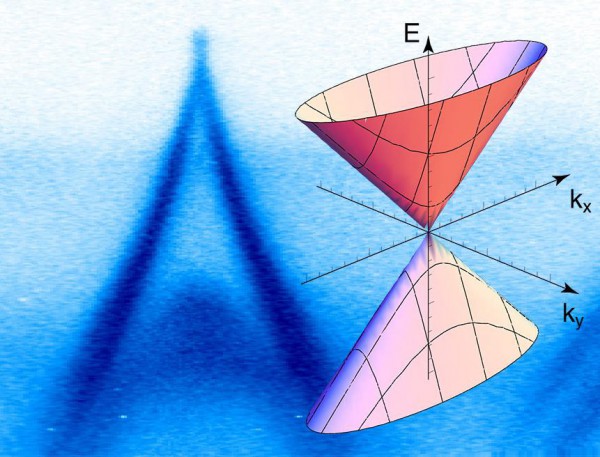Eyeing potential uses, MARVEL researchers pursue discovery, design of topological materials
by Carey Sargent, EPFL, NCCR MARVEL
Such materials, which gained their name because their phases can be described by the mathematical field of topology, may be critical elements of quantum devices of the future. NCCR MARVEL researchers led by Professor Oleg Yazyev, who holds the Chair of Computational Condensed Matter Physics C3MP at EPFL, Professor Alexey Soluyanov of the University of Zurich and Professor Ming Shi at the Paul Scherrer Institute, are building on the work of the last decades to find and develop the topological materials that could eventually be used in superconductors, new generations of electronics and quantum computers.
The grand challenge is to ensure the presence of topological materials in future technologies and to enable novel applications, ranging from traditional electronics to quantum computing, thanks to these materials.
—Project Leaders, NCCR MARVEL Design & Discovery Project 6
It all started back in the 1980s, when researchers—including David J. Thouless, F. Duncan M. Haldane and J. Michael Kosterlitz, who later won the 2016 Nobel Prize in Physics for their work—developed a topological interpretation of the curious phenomena observed in condensed matter systems with strong electron-electron interactions.

Predicted, experimentally measured Dirac fermions on surface of topological insulator © 2018 EPFL
Broadly speaking, topology can be used to describe the quantum states of materials as mathematical objects with a set number of holes—a donut would be classified as one type of object, a roll as another. According to the theory, topological properties of an object remain the same under any smooth deformation of the object (say, a stretch, a rotation or a twist), that is, as long as they keep the same number of holes and do not switch to another topology. Materials in which these states are realized, feature robust observable properties, even in the face of significant temperature changes or deformation of their physical structures, unless the topology of the state remains unchanged. These changes from one topological phase to another occur step-wise rather than in a continuous flow. It is these two characteristics that make topological materials interesting candidates for future technological applications.

While the three Nobel-prize winning researchers opened up the important path of topological phases in materials, the fact that their work focused on materials with strong electron-electron interactions—the most difficult element of the materials prediction problem—meant that no one was able to realize the predicted phases experimentally at the time.
It was two decades later that Shoucheng Zhang of Stanford University, Charles Kane and Eugene Mele of the University of Pennsylvania understood how to realize topological phases in systems with weak electron-electron interactions. There are many examples of these systems among materials that can be studied with existing numerical techniques—this meant that their topological phase could be computed and experimentally verified. For example, Zhang and colleagues predicted in 2006 that mercury telluride should be a 2D topological insulator, and this was confirmed experimentally the next year by Würzburg University’s Hartmut Buhmann and Laurens Molenkamp. All five won the 2010 Europhysics Prize—one of Europe’s most prestigious in the field of condensed matter physics—for their work.

In short, the work of the Europhysics Prize winners, which involved a simplification removing the necessity of strong interactions, allowed scientists to verify that the topological phases discussed in the 1980s can actually have illustrative examples in samples of real materials. This created a new field of topological phases of matter and gave rise to a variety of real materials hosting such phases: NCCR MARVEL researchers have already made significant contributions. The groups of Yazyev and Soluyanov worked to develop the general methodology for the search and prediction of topological phases in materials and Shi’s group was one of the leaders in the experimental realization of these predictions.

But now that weakly interacting topological phases have been realized in materials, the task comes back to the original predictions of the 1980’s. The goal of MARVEL’s Design and Discovery Project 6 is to find strongly interacting topological phases, which require a much more ambitious effort to be realized in materials. Strongly correlated materials—those with strong electron-electron interactions—require novel methodological approaches and are currently only available only for low-dimensional systems. The groups of Yazyev and Soluyanov plan to develop these methodologies, with a particular focus on identifying topology in interacting compounds.
“The technological promise here is enormous, especially for quantum information processing, and also for the possible understanding of yet not explained physical phenomena, like high-T superconductivity,” Soluyanov said.
The project leaders also plan to move from high-throughput searches for candidate topological materials to actual materials design. Starting from selected confirmed and candidate topological materials, they will develop strategies for designing novel materials by varying along the degrees of freedom such as chemical composition, strain or material combinations in heterostructures. Finally, they intend to address various aspects relevant to prospective technological applications of such materials through device-scale simulations.
“The grand challenge is to ensure the presence of topological materials in future technologies and to enable novel applications, ranging from traditional electronics to quantum computing, thanks to these materials,” the group leaders said.
Low-volume newsletters, targeted to the scientific and industrial communities.
Subscribe to our newsletter